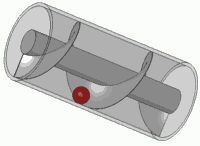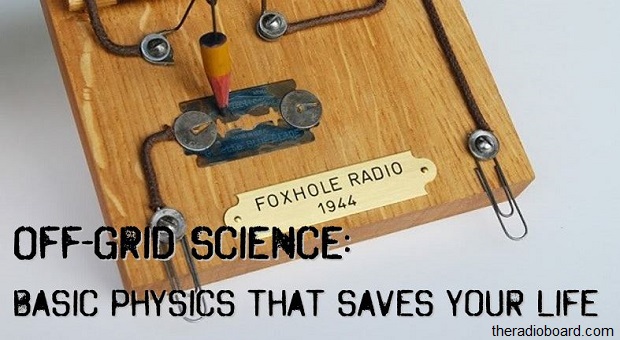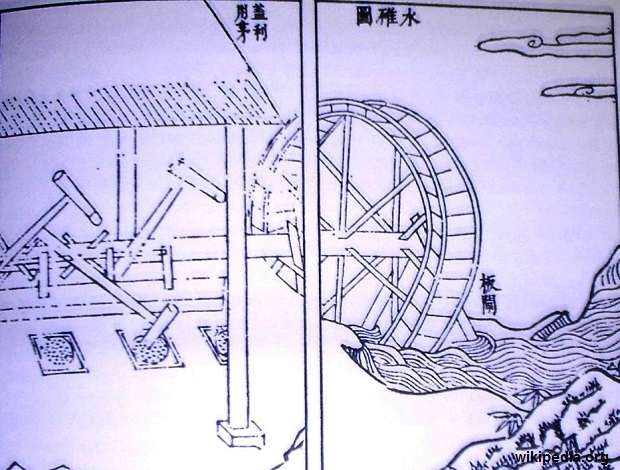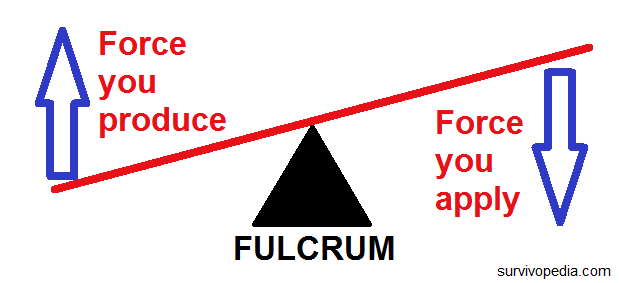When people hear the word “physics”, they often think of complicated mathematical equations, hulking computers, and other “technologies” that require being a genius to build.
On the other hand, “physics” as a survival science has occupied humanities for thousands of years. No matter whether you study texts from India, Egypt, China, and even classical Greece, you will find hints of physics in each society.
From that perspective, if you truly hope to survive a crisis scenario and enable the next generation to move forward, learning the fundamentals of physics is very important.
This article is intended only as an introduction to basics of physics. With further research, they can help you generate power and maintain rudimentary communications to survive off-grid, or in a future world where modern utilities are dismissed.
1. ENERGY & MATTER
If you have ever heard of Einstein’s famous equation: E = mc2, then you already know that energy and matter can be exchanged.
Since “c2” in the equation is the speed of light squared, the equation implies that relatively small amounts of matter can release huge amounts of energy. By the same token, it takes a great deal of energy to transform into just a few molecules of matter.
Thinking about energy and matter as two discretely different things can lead to a very common series of misconceptions that you will find lurking even among students of physics. For the sake of survival physics, you are far better off thinking of energy and matter as being two states of the same vibrating “stuff” that underlies all that is in the universe.
Once you start thinking about energy and matter as being related, it is much easier to plot the states of matter (solid, liquid, gas) on the same linear path as you would energy “states” or “bands” (examples include audible sound, visible light, UV, etc).
Things You Can Build
Your body and everything around you depends on the interactions between energy and matter. As a result, there are literally millions of devices you can build. The key to building effective and efficient devices will always be grounded in finding the best materials and ways to arrange them for specific purposes.
For example, you can easily build a solar cooker from a cardboard box with a tinfoil cone and use it to heat up your lunch. On the other hand, if you want to capture more heat and light from the sun in order to generate steam, you will need to use materials that will not burn up or be ruined by the incoming power.
2. ELECTROMAGNETISM
Many people interested in crisis preparation feel that it is not important to learn about electricity or any devices that rely on it, and rely only on building an energy supply.
Unfortunately, these are the very same people that will not know what to do when they encounter electronics in the form of waste that can be extremely harmful to health and wellness.
Even at the very simplest level of being able to navigate using a compass, you will truly be in a sorry condition if you do not keep in mind that electromagnetism is responsible for the movement of the compass, and that magnets or hidden electronic equipment can throw you off course.
Aside from that, not knowing the fundamentals of electromagnetism will make it very hard to communicate over long distances, repair devices, build new devices, and detect the presence of intruders using RFID (Radio-Frequency Identification) or other technologies.
In fact, even if an EMP strike temporarily silences the world of electromagnetic devices, older forms and rebuilt versions may, indeed, make a comeback sooner than expected.
Things You Can Build
As with interactions between energy and matter, there are literally millions of simple and complex devices that you can make that harness the power of electromagnetic fields. This includes devices that will produce electricity, perform manual labor, or store, and transmit information.
Some of the most fascinating devices in this arena were developed by Tesla. For example, the Tesla turbine is one of the most fascinating combinations of mechanical energy and electromagnetism. Once you get the disks to turn, simply attach magnets and let them spin near a coil of wire.
Video first seen on Y T Engineer
If you happen to be interested in communications devices, you do not need to rely on solid state technology to communicate across large distances. For example, during WWII, soldiers were able to tune into all kinds of radio transmissions by using a “foxhole radio”. These devices used little more than a razor blade and a few other simple parts that made them just as efficient as crystal radio sets.
Some simple electronic components you should always know how to build from scrap materials include:
- Resistors – impede the flow of electricity so that it can be directed to another location.
- Capacitors – build up electricity on one side, and then when enough charge builds up, it is released through the other side. Capacitors are ideal for building joule thieves, which can be used to increase the voltage over what is produced by a battery.
- Diodes – only allow current to flow in one direction. They are useful for amplifying and fine tuning signals received from an antenna. Even though many diodes on the market today utilize semi-conductors, you can still build them without using these types of materials. If you are concerned about EMP attacks, learning how to make diodes without semi-conductors is very important. Even though you may not be able to rebuild your smart phone or other complex equipment, you can still build radios, transmitters, and timing devices.
- Coils – it is fair to say that coils are the work horse in the world of electromagnetism. They can be wound into balls that drive motors, or arranged into toroids for creating compact electromagnetic fields. Rodin coils are also of interest if you are looking to experiment with unique field shapes and their effects.
- Antennas – can be made using bar coils or from simple pieces of wire. Antennas can be used to pick up all kinds of radio waves, which are then deciphered and translated back to understandable from by other electronic components.
3. POWER AND GRAVITY
There are people that feel “less is better” or that they should simplify as much as possible so that fewer things will go wrong after a crisis strikes. This belief is especially prevalent when it comes to studying conventional science and electronics. It is also extremely dangerous because:
- Collapsing governments will still have various technologies at their disposal that can be used to find you, overwhelm you, and take all that you have struggled to gather up for a time of need.
- Other groups of survivors that placed a focus on preserving knowledge of physics, electronics, and other sciences will rebuild faster. As these groups rebuild, they will eventually find you and over power you because they have more resources at their disposal.
- After a crisis strikes, finding other groups may be critical to long term survival, especially if you need to pool resources or information. Without being able to pick up and transmit communication signals, your group will be left out any progress made towards rebuilding society. This will make it harder for your group to survive and produce future generations.
Regardless of your belief system, it is very important to realize that knowledge is a form of divinely inspired power that is given to us to be effectively wielded for our own needs. Without a basic understanding of power (both as a form of knowledge and also the tangible ability to do work in the physical world) and gravity in the arena of physics, you will find it very hard to meet even the simplest survival goals.
This includes everything from being able to effectively use guns and knives to hunt and protect yourself, build traps, and carry out an endless number of fundamental tasks.
Things You Can Build
When it comes to power and overcoming the gravitational field, you will find many fascinating devices.
If you are looking to transport an object from one place to another, wheels offer the best way to reduce the impact of weight. In order to make the best wheels, it is important to be able to control both speed and direction of motion.
Therefore, you will also need to consider the effects of friction at the point where the wheel touches the Earth. Typically, you will have to choose the best trade-off between sufficient traction and reducing friction enough to move forward with ease. You can modify the wheel itself, or make changes to the surface the wheel travels on in order to create the best combination.
In the arena of power and gravity, pumps are also very important devices. Aside from hand pumps used to obtain water, you  might also be interested in creating an Archimedes Screw.
might also be interested in creating an Archimedes Screw.
Essentially, this is a “screw” shape housed inside of a round tube. As the screw turns, it draws water upward despite the effects of gravity.
Even today, the Archimedes Screw is a relatively simple technology that is being used to generate power and pump water. For example, Windsor Castle is powered by two Archimedes Screws that have been in service since 2011.
No matter whether you need to pound grain to make flour or forge new gun parts, hammers are vital tools that will help you survive and rebuild after a disaster. That being said, a human being can only lift a hammer so high in order to take advantage of gravity.
By contrast, trip hammers developed in China hundreds of years ago make the most of gravity and water wheels. Each hammer was positioned in such a way that the handle was resting on a bar that did not allow it to touch the ground. From there, the shaft of the water wheel was extended and fitted with spikes.
These spikes, in turn, were arranged in such a way that they would push the handle of the hammer upward as the wheel turned. Once the spike moved away from the hammer handle, the hammer end would fall down and strike anything beneath it. Think of a see-saw powered by a water wheel, and you have a good idea about how these trip hammers work.
Several hammers in a row can also easily be fitted to a single water wheel in order to create multiple stations. Since waterwheels can power much larger and heavier hammers than can be lifted by a human, this particular trip hammer design can easily be used to create stamped metal parts, forge raw metal into everything from horseshoes to car engine parts, or pound nuts and grains into flour.
Additional modifications and combinations with gear assemblies may also enable the trip hammer to be used for drilling, polishing, and other purposes.
4. TIME AND SPACE
During your adventures in physics, you will find that there are many places where “power” plays a role in the exchanges between energy, matter, and the four fundamental fields of nature.
Typically, all of these interactions are measured in physics by elapsed time and traveled distance. If you ever get stuck trying to work through a physics equation, always remember that it must come down to specific time frames and distances.
Surprisingly enough, if you understand and use this concept, you do not need programmable calculators or complex mathematical software to do physics calculations.
Things You Can Build
Aside from serving as a framework for just about everything you do in daily life, there are some specific places where you will be primarily concerned with time and space.
Even though you may use other aspects of physics to build devices in this category, their sole purpose will be to measure or manipulate time and space in order to achieve other goals.
Some devices you can build include:
- Navigational aides such as compasses. You can also take advantage of light optics to locate the position of the sun using Iceland Spar Selenite.
- Seasonal timing for crops and harvesting – being able to track and record the position of planets and constellations can give added reassurance about when to plant or harvest crops. In addition, watching the skies carefully for specific weather patterns is also very important if you need to evacuate or prepare to bug in before floods or other catastrophic storms strike.
- Create and use calendars – these devices will keep your group organized and help re-develop a social order that helps you survive and thrive. Typically, it is very hard to create a useful calendar if you are unaware of the physics of motion and time, and how to translate them into a useful system.
- Time and space considerations are also critical to the development of gear systems that can be used to propel robots and many other devices. Without a proper sense of timing from point to point, you will find it very hard to align gears and determine which size gear belongs in each position.
5. MECHANICS (Pulleys, Gears, Levers, Springs, Fulcrums, and Inclined Planes)
In the absence of electricity, you will need to find means of propulsion that rely on mechanical energy. Historically speaking, the Mesoamerican cultures and many other ancient societies developed some fascinating devices that could move huge blocks of stone, build irrigation systems that went for miles, and even create moving robots and sanitation systems that rival our modern devices.
Regardless of the device, you will find that many of them relied on systems of pulleys, gears, levers, and fulcrums. While some physics text books integrate this information into other sections, you should initially acquaint yourself with these devices from a hands-on practice position instead of trying to understand their math on paper.
At the very least, if you take this approach, you will be able to build all kinds of useful devices without stressing out because your scientific calculator got destroyed by an EMP blast.
Pulleys can be used to:
- Lift heavy weights such as automobile engines and transmissions.
- Transmit power from one drive shaft to another in rotating shaft in a system. For example, if you look at your automobile engine, you will see a series of belts and pulleys. Usually, the largest and heaviest belt is called the serpentine belt. One side of this belt is driven by a pulley that is turned by the engine, the other side of the belt goes around a pulley that may have one or more grooves. Each groove, in turn, is attached to another pulley in the system that connects to another device.
This system of pulleys and belts takes the power created by the engine and transmits it to the alternator, air conditioner motor, and other motors attached to the engine.
It should be noted that not all motors in modern automobiles are fed off the serpentine belt. Instead, they rely on electricity generated by the alternator. Sadly, and possibly to the demise of many drivers, power steering and power brakes motors rely on power from the alternator instead of getting it directly from the engine and its belt system.
Some devices you can build with gears include:
- Watches and clocks
- Simple calculators and computers
- Automobile transmissions
- Possibly as part of an exhaust catcher for an aeolipile.
A fulcrum is a pivot point. Usually, it sits on the ground and serves as a resting point for a lever. When combined with levers, fulcrums can be used to build many things, including war machines.
A lever is a bar that sits cross-ways in relation to a fulcrum. If you can visualize a see-saw, then the bar where each person sits corresponds to the lever. When it comes to a discussion of levers, you must always consider that the length of the lever and its location in relation to the fulcrum will determine how much power it can deliver, and also how much energy it will take to move each end.
A spring is essentially a helix, or coil of wire that can be stretched out or compressed. Depending on the spring design, mechanical energy can be stored when the spring is compressed. Other springs can also pull objects closer together after they are allowed to compress back to a shorter state.
Springs are extremely useful for powering a range of devices when electricity is not available. This includes watches and clocks that utilize gears. Springs can also be used to launch projectiles such as BB’s. When combined with other “simple machines”, you are sure to find many other ways to incorporate springs into your designs.
It should be noted that springs and twisting ropes do not work in precisely the same way. Even though both devices can store power as they grow shorter, springs do not necessarily need to be wound before compressing them. That being said, never underestimate the capacity of twist ropes to store mechanical energy.
Some devices that are built using a twisting motion include:
- Siege machines – these devices were used to breach fortification walls. Ancient siege engines were capable of launching rocks and other projectiles. Eventually, these systems became the foundation for cannons and other artillery devices.
- Catapults – Even though catapults can be used to hurl large projectiles to break walls, they can be used for other offensive purposes. This includes launching lighter weight projectiles over walls where they can do more damage. For example, a ball of flame launched over a wall can set grain and other materials on fire while siege machines do their job of breaking down the walls. Catapults can also be used to defend a wall or central location if large numbers of unwanted guests are spotted in the distance.
- Automatic fire crossbows – When it comes to precision firing and powerful weapons, crossbows are quite effective. Twisting ropes combined with other mechanical devices listed in this article can be used to shift arrows into a firing position automatically. Thus, even if you do not have a machine gun or some other “automatic” weapon, a well-constructed automatic fire crossbow can still be of use.
As ancient as some of these devices may seem, they can still deliver an enormous amount of resistance against invading groups. In fact, a well-designed and well-aimed crossbow can take down helicopters or drones if the arrows hit the right spots.
By the same token, siege machines may be a used to launch any number of burning materials and chemicals that can neutralize tanks and large numbers of people. Even if these people are wearing bullet-proof or fire proof vests, these devices can still maim and cause other types of damage. This is especially important to consider if you are part of a larger survival group and need larger scale devices to protect yourself from those who want to take from you or destroy your settlement.
When it comes to devices commonly found in discussions on physics, few are as simple or as effective as inclined planes, or ramps. Aside from making it easier to push objects from a lower point to a higher one, ramps can also be used for many other things.
For example, rollers with a belt over them can be used to move objects from one place to another using a smaller inclination. Inclined planes can also be combined with pulleys and levers to pull heavy objects upward with increased efficiency.
Physics can somewhat loosely be summarized as the study of the interactions between faster (energy) and slower (matter) vibrations, and how these interactions play out and are changed by the four fundamental fields of nature. Even though contemporary physics makes a distinction between classical and quantum mechanics, eventually the two systems must fit into a coherent whole.
Until that event happens, never be afraid of the confusion that may occur when you encounter concepts that your instincts say are wrong. In some cases, your senses may simply be telling you something that cutting edge researchers have yet to discover, and therefore claim is wrong.
Instead of being discouraged, continue studying physics and see how you can apply basic information to your survival needs. If you see other survival uses for these principles, share your thoughts about this in the comments section below!
This article has been written by Carmella Tyrell for Survivopedia.
About Carmela Tyrell
Carmela Tyrrell is committed to off gridding for survival and every day life. She is currently working on combining vertical container gardening with hydroponics. Tyrrell is also exploring ways to integrate magnetic and solar power generation methods. On any given day, her husband and six cats give thanks that she has not yet blown up the house. You can send Carmela a message at carmela.tyrell [at] survivopedia.com.







